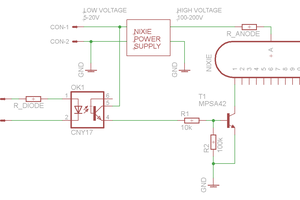 |
| × | 1 |
| ||
 |
| × | 1 |
| ||
| × | 1 | ||||
| × | 1 | ||||
 |
| × | 4 | |||
 |
| × | 1 | |||
 |
| × | 1 | |||
 |
| × | 1 | |||
 |
| × | 1 |
| ||
| × | 1 | ||||
| × | 1 | ||||
| × | 1 | ||||
 |
| × | 1 | |||
| × | 1 | ||||
| × | 1 | ||||
Currently, there are mechanical switches to turn on and off of devices involving high current and high voltage like drones, solar power grids, high power appliances etc. In custom-made drones, power is provided by plugging in the LiPo battery. These mechanical operations create sparks and hence cause wear and tear of connectors or even burning. Sparks are generated due to more presence of inductive or capacitive elements in load i.e BLDC Motors and Capacitors in ESCs. The battery voltage resists the connection of load and hence ionizes thin layer of air and causes sparks. Higher the voltage Higher the sparks. This burns the plastic part of the connector or destroys the gold plated connectors. There are examples where connectors gets destroyed in mere 10 to 15 operations of plugging in and out. This problem also persists in mechanical switches involving power hungry loads. Along with connectors some sensitive circuits in drones gets destroyed due to peak current surge in the circuit while connecting.
The smart soft switch will be using 600 V CoolMOS™ C7 Gold superjunction MOSFET for switching on and off. Single push button to turn ON and turn OFF. Hence there will be no or minimal loss in energy and no damage to switches or connector.
Currently, there is no soft switch available for custom drones or for high power appliances people use mechanical switches or battery connectors to power up these devices. This causes issues like sparks and burning of external plastic housings or even the switch itself.
Step One: What the end goal is....?
A push button based ON/OFF switch using CoolMOS™ C7 Gold superjunction MOSFET also the smart soft switch will be very useful as it can switch between on-off without any significant loss energy also it is smart an hence it can measure the current flowing through it.
Step Two: Gather all the required hardware
I have mentioned all the required components in things section
Step Three: Schematics
Complete Schematic
As we can see the schematics involves many passive and active components for this circuit. This involves 2 sections switching section and data acquisition section. In data acquisition section micro-controller reads the current consumption and records data in SD cards and also displays it on OLED screen. Here I'm using 0.96" I2C OLED display and Arduino Pro Mini for micro-controller. CoolMOS™ C7 Gold superjunction MOSFET serves as a heart of the circuit by performing switching action. Here I will do the prototyping on the perf board as my PCB is not ready yet. You can find the schematics and PCB designs at www.github.com/vishwasnavada/SoftSwitch
Step Four: Working
Initially the capacitor in the circuit is discharged and hence there is no signal at the base of the PNP transistor BC557, hence the output of the transistor will be low and hence CoolMOS™ C7 Gold superjunction MOSFET will be turned OFF.
The capacitor gets charged by the resistor R4 (330K) to the maximum input voltage. When the button is pressed this voltage goes to gate of the MOSFET turning the MOSFET on rapidly followed by transistor.
If the switch is held closed the gate voltage will be defined by the voltage divider formed by R1 and R4. Since Q1 is saturated the junction of R1 and R2 is pulled up to +Vs (Supply voltage). The junction of R3 and R4 is pulled down to zero volt by MOSFET drain. With the switch closed the the Vgs of MOSFET is given by
Vgs= Vs*R4/(R4+R1)
which is 12*330K/(340K) = 12*0.97
... Read more » Vishwas Navada B
Vishwas Navada B



 Christoph
Christoph
 kevarek
kevarek
 Tijl Schepens
Tijl Schepens
 Azri Jamil
Azri Jamil